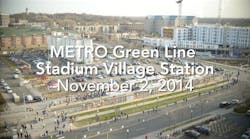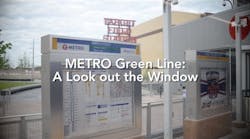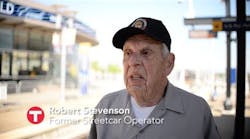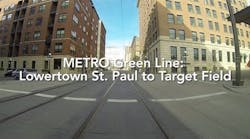University Avenue connecting Minneapolis and St. Paul, Minnesota, has played an important role in moving people of the Twin Cities region for more than a century.
Brian Lamb, general manager for Metro Transit, said the tradition stretches back more than 100 years where the University Avenue corridor held one of the region’s first streetcar interurbans.
The area fell out of favor with mass suburbanization following World War II and lead to a decline along the corridor.
“The corridor fell on hard times and it never found its way again,” Lamb said. “But over the course of the last 20 years, there was a renewed interest in creating a light rail connection between the two downtowns.
The Central Corridor Project connected a traditionally strong commercial corridor between Minneapolis and St. Paul, so when it got approval to move forward, the area began a journey to create the Green Line to connect the downtown areas of both cities.
Building a Bigger Workhorse
Lamb said the corridor included the workhorse bus route of Metro and it always held high potential for ridership, but the Green Line was passed over for being the first light rail line in the area. The Hiawatha Line opened in 2004, connecting the Mall of America and the Minneapolis-St. Paul International Airport into downtown Minneapolis.
“It was a function of project readiness,” Lamb said. “For Most of those linear miles, there was already a commitment to making major road improvements and there was significantly less in linear miles where significant purchases of property were needed.
“The central corridor was much more complex and it wasn’t going to be possible to be able to do it as cost effectively or cheaply as the Hiawatha.”
Lamb said connecting into two downtown areas caused complex issues running the route along with center running tracks on University Avenue, so it had to balance access for cars while still making it a system that could compete time wise to a car commute.
Lamb said Metro had to acquire an entire city block in downtown St. Paul to create a turning block for the North-South to East-West alignment as the line terminates at Union Depot.
“This was a really great opportunity to stimulate development,” he said. “Not including the $1 billion stadium being constructed along the Green Line corridor, since 2007 when we started the project through 2014, there has been a documented $2.8 billion in new development that really has stimulated the economy and actively focused on higher density development.”
Lamb said Metro Transit has worked with local jurisdictions on development opportunities near stations. This meant looking at specific land acquisitions to created development while balancing with visionary planning within each neighborhood and the creation of new zoning rules to allow for higher density development to encourage transit-oriented development.
Getting the Green Line built meant the region had to invest nearly $1 billion in public funds on a single project. The cost sparked debate about regional priorities on the local political levels. Lamb said Metro used the momentum of the Hiawatha line — which was already exceeding its 2025 ridership projections — to solidify support for the second line.
Metro held more unconventional outreach events with local community groups, such as coffee discussions about the project and also regional partners hosted trips to other successful light rail lines in the nation to see what potential the Green Line could hold.
“One of the things I think was important is we definitely added the Green Line of the most diverse corridors in the Twin Cities area by far, so we really wanted to make sure elected officials up and down the line fully understood the importance of an efficient transit system,” Lamb said.
There were more than 8,000 new housing units added along the Hiawatha Line before the Great Recession hit in 2008, so Lamb said leaders had proof the Green Line could create development. Lots of development happened concurrently to the Green Line’s construction and development is already happening along the planned corridor expansion for the line.
“There’s more of a developer understanding and degree of confidence that there are a lot of people who want to live and work along a transit corridor,” Lamb said.
Collaborating for Success
Justin Gabrielson served as project manager for a joint venture of Ames/McCrossan, which handled construction of the western portion of the Green Line project. He said access was a big concern on that area due to a double decker bridge across the Mississippi, which had car and pedestrian traffic along it and building through the University of Minnesota campus.
The campus portion also meant installing an electromagnetic interference zone in the university’s research corridor to inhibit EMI.
Gabrielson said construction crews fenced in working areas and did walks with community stakeholders through the construction zone on a regular basis to ensure pedestrian access during the build, which also met the Americans with Disabilities Act requirements.
“In the U of M area there were literally hundreds of areas we were dealing with,” he said. “Essentially you’re dealing with 30,000 people working through your job site on a daily basis.”
The double decker bridge has pedestrian access on the top level and rail lines were added to the traffic level, which originally had four lanes for cars. Gabrielson said they shut off traffic one direction at a time during the build and installed a specifically-designed overhead crane.
Gabrielson said having a direct relationship with all the community stakeholders and the joint venture, the designers and construction agencies were able to discuss specific issues each time they entered a new zone or neighborhood so they could come up with the best solution. Lots of specific issues can be of concerns in a community and planners and crews would never think of considering unless they hear about it from the community.
“Access is the main one,” he said. “What will it look like, how long is this going to be on my property, businesses are trying to stay in business, so they want to know how people are going to get in and out of their business.”
The joint venture also cohabitated offices with Met Council construction staff, Gabrielson said, which was extremely important for making sure the project was completed on time because issues could be resolved in a face-to-face manner very quickly after they arose.
“There was a door with an arbitrary wall between us, so if there was an issue we could walk right through that door as opposed to sending an email and driving five miles,” he said. “We were right there to work it out. It was very important for getting the project completed on time because there are a lot of moving parts.”
Metro tapped Siemens to build railcar equipment and provide signaling devices for the project.
Michael Cahill, president of the Siemens Rail Systems Division, said design for the Green Line cars took special consideration due to the harsh climate of the Twin Cities region. Trains needed insulation and additional heating capacity was added to the HVAC system, along with efforts to protect against corrosion.
The company had to work with the agency in a collaborative effort to determine what Metro’s needs were and the final product is 6 percent lighter than older trains to increase efficiency.
“They chose the options, but in terms of the maintainability of their system, I think we learned a lot from each other,” Cahill said. “From the best positions of equipment to make for easier replacement of hydraulic hoses, to how to best heat cars in the cold winters, to looking at how they opted to take the side mirrors off and put on security cameras on for the modern times. All of these things came from a very collaborative effort.”
A new light rail line also meant Metro and communities impacted by the Green Line needed to plan for changes in security.
Metro Transit Police Capt. James Franklin said the department took a collaborative effort within and outside of the organization to pinpoint concerns and address them along the line.
The department worked in conjunction with the safety department to find any concerns in the design or build out of the line and to plan for all the major venues served by the line. Then Franklin said they worked with the other safety and security agencies in the area to plan for the line, such as the St. Paul Police Department; St. Paul Fire Department, Ramsey County; and the University of Minnesota Police Department.
“We did a significant amount of public outreach to educate the police and fire department about what the light rail line is, what the hazards that are associated are, such as the catenary lines and how that’s a 750 volt DC current, so you don’t want to touch that if it’s a down line,” he said. “Once we did the outreach, we did some hands on training.”
Franklin said the training entailed showing emergency workers the rail cars and how they would operate when opened, then practicing coordinated events ranging from small issues to mass casualty events. Training provided the agencies with clarity on their roles for daily and major operations issues. Franklin said after reaching out to them Metro Police discovered there was a large appetite for hands on training on those areas within the other agencies.
“I think getting in front of the issues and getting public safety partners together and really bonding those partnerships and relations is really important so you have those strong relationships,” he said. “You need to bring them to the table, to these exercises and committees.
Franklin said Metro Police’s biggest concern with the opening of the line was pedestrian and car traffic and safety issues related to the new line. The department launched a public relations campaign to get the word out to the community about safety issues with the line. They educated the public about driving and pedestrian behaviors and urging them to use common sense by the rail line.
“Just the volume of people we were trying to reach, that was the only challenge,” Franklin said. “Truthfully, there wasn’t any other real challenge other than the workload and trying to manage it.”
Opening With a Boom
The construction project employed 5,500 people along with 200 permanent operations jobs. And when it opened, people of the Twin Cities flocked to the gates.
The line opened June 14, 2014. More than 107,000 riders boarded by the end of the first weekend. An average of 27,805 riders got on board the first week. More than 1 million rides took place in September. By the end of 2014, 6.5 million rides took place on the Green Line, with an average weekday ridership of 34,548.
By April 17, the weekday average reached more than 36,000. The ridership goal is 41,000 by 2030.
The workhorse bus route ridership dropped from a daily average of 16,000 and stopping every block to about 3,000, with stops every other block. It runs every half hour and Lamb said it helps transfer riders to the Green Line.
“When we look at the combined ridership, we know the combined ridership between the Green Line and the buses nearly doubled since the Green Line opened,” said Howie Padilla, public relations manager for Metro Transit.
Marketing to Green Line riders meant changing how Metro targeted potential customers due to a big shift in demographic compared to the Hiawatha Line. Lamb said unlike the first line, the Green Line doesn’t connect with a single park-and-ride.
“We have a really strong transit ridership and we’re also seeing some great transformation with more housing density along the corridor, the (University of Minnesota) campus runs right through the corridor, right through the center of campus,” Lamb said. “So our marketing is very targeted to the Millennial generation.”
Running a light rail line through a major arterial also challenges Metro to make the Green Line service customers without impeding pedestrian and car traffic.
Brian Funk, director of light rail operations for Metro, said the Green Line goes through more than 60 traffic signal controlled intersections without a protected grade crossing. The line was equipped with a transit signal priority system to keep a green band for an approaching train an additional 10-12 seconds to account for dwell time at a stop. Metro did pre-revenue service testing of the system, but when it went live, things didn’t go quite as planned.
The Green Line started operations with an expected route time of 48 minutes, with a threshold of four minutes set to determine if a train was late. By the end of its first full month of operation, only 50 percent of trains were on time.
“It was really difficult because of the variation in dwell time and traffic timing and being not a grade separated railway, so we were interacting with all those elements,” Funk said. “And all those elements were a were a little more unpredictable than we had thought in the planning stages.”
Funk said Metro, consultants and city engineers from St. Paul and Minneapolis looked into the issue and peer agencies to solve the tardiness. They opted to change the signaling system with predictive priority signaling system similar to Valley Metro’s light rail system in Phoenix. Instead of creating a green band hold, Funk said a signal is sent to the intersection prior to the train’s arrival and it adjusts accordingly.
Existing equipment was reprogrammed and no additional procurements were needed.
The on-time rate jumped to 60 percent by August, 70 percent by October, 75 percent by November and 85 percent by December. By February, the on-time performance was at 90 percent
“It improved so much we realized there were areas where we had two minutes between stations and looking at average travel times, we didn’t need the full two minutes, so what we did is back in December we made a recommendation that we would change the schedule,” Funk said. “The 48 minute schedule was virtually unattainable when it first opened, but we reduced it to 45 minutes on March 7.
“When we gave it the predictive treatment, there was no negative impact to the other traffic at the intersections and even now with three less minutes, we’re still up above 85 percent on-time and we continue to improve that with additional refinements.”
Funk said having six to eight weeks of pre-revenue service testing would be ideal the next time a line is opened, along with continuing the partnerships with city engineers to refine the corridor. While it was being built and tested, he said Metro engineers brought city engineers along on tests to see perspective from the train, while transit engineers went with transportation engineers to look at challenges at streets and for roadway traffic.
It’s definitely a great benefit to have a strong partnership with the city engineers are operating staff,” Funk said. “It’s really a lot of coordinated effort to make little adjustments.”
Funk said the Green Line and Blue Line come together in downtown Minneapolis, with a goal of having five minutes between trains, which means a unit is passing through an intersection every 2.5 minutes. Officials are working to optimize inbound trains and mitigate delays, which carry out the rest of the line.
The line ends at the Minnesota Twins stadium in Minneapolis, while connecting to the Target Center where the Minnesota Timberwolves play; the Minnesota Gophers stadium, the new Minnesota Vikings stadium currently under construction; and in St. Paul the Xcel Arena where the Minnesota Wild plays and a minor league baseball stadium connects its right field fence with a Green Line station.
“We’re really excited to be creating a sports corridor aspect, so we think the Green Line will continue to grow ridership in all sorts of different ways,” Lamb said. “And you know how there has been an explosion of brew pubs in certain areas of the country? Well, in terms of brew pubs, literally half a dozen have popped up too, so you know, it’s not just about creating those opportunities to commute going to work or school, but along the corridor there are all sorts of recreational spots.”






